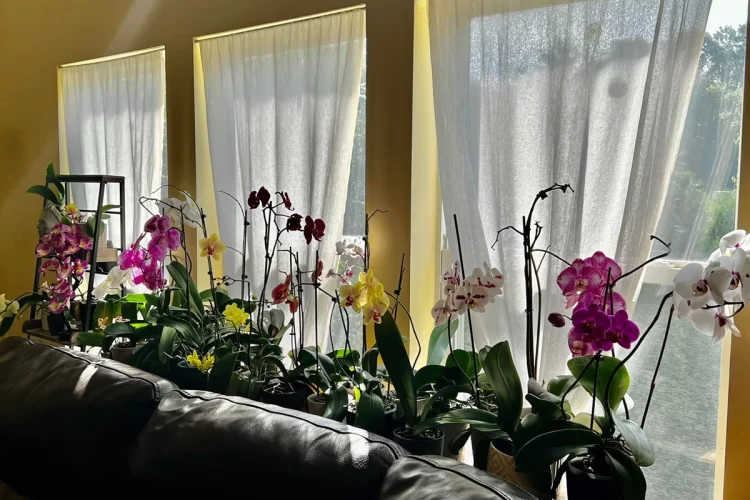Orchids are some of the most captivating and diverse flowering plants in the world. Growing these exotic blooms indoors can transform any living space, providing elegance and a unique visual appeal. This comprehensive guide covers everything you need to know about cultivating orchids in your home, from selecting the right species to creating optimal growing conditions.
Why Grow Orchids Indoors?
Orchids are renowned for their vibrant colors, intricate shapes, and long-lasting flowers. Indoor orchid growing allows enthusiasts to enjoy these spectacular plants year-round, regardless of outdoor conditions. Orchids are also relatively low-maintenance and add an air of sophistication and beauty to any room. With over 25,000 species to choose from, there’s an orchid to suit every home and style.
Choosing the Right Orchid for Indoor Growing
Not all orchids thrive indoors, so selecting the right type is essential. Below are some popular and beginner-friendly options that flourish indoors:
Phalaenopsis (Moth Orchid)
Phalaenopsis orchids are among the easiest to grow and are highly recommended for beginners. They bloom frequently, with flowers lasting up to three months, making them an excellent choice for adding color to indoor spaces.
Dendrobium
Known for their slender, reed-like stems and delicate flowers, Dendrobium orchids are ideal for bright indoor areas. They require a bit more light than Phalaenopsis but are otherwise easy to maintain.
Cattleya
Cattleya orchids, often called the “Queen of Orchids,” produce large, fragrant blooms that can be the centerpiece of any room. They do best in brighter conditions and require slightly more attention but are well worth the effort for their stunning display.
Oncidium (Dancing Lady Orchid)
With their charming, delicate flowers, Oncidium orchids are suitable for intermediate growers. They need ample light and humidity but reward their caretakers with intricate blooms.
Creating the Ideal Indoor Environment for Orchids

Indoor orchids thrive when specific conditions are met. Providing the right amount of light, temperature, humidity, and airflow can ensure healthy, vibrant plants.
Lighting Needs for Orchids
Orchids generally need indirect, filtered light. Position them close to an east- or west-facing window for ideal light exposure. Avoid direct sunlight, which can scorch the leaves. If natural light is limited, particularly in winter, try using grow lights to enhance lighting.
- Phalaenopsis and Paphiopedilum: Low light; ideal near a north-facing window.
- Dendrobium and Cattleya: Medium to high light; thrive near an east- or south-facing window with filtered sunlight.
- Oncidium: High light; best near a bright window with some shading.
Temperature Requirements
Orchids have specific temperature requirements that vary by type. In general, most orchids prefer:
- Daytime: 65°F to 80°F (18°C to 27°C)
- Nighttime: 60°F to 70°F (15°C to 21°C)
Tip: Orchids benefit from a slight drop in nighttime temperatures, which can encourage blooming.
Humidity and Air Circulation
Orchids thrive in a humid environment. Maintain a humidity level of 50% to 70%. Using a humidity tray or placing the pot on a saucer filled with water and pebbles can help maintain moisture. Additionally, ensure proper airflow around your orchids to prevent mold and rot. Consider using a small fan near your plants to improve circulation.
Potting Medium and Containers
Unlike other houseplants, orchids do not grow in soil. Instead, they require a well-draining potting medium, such as bark, sphagnum moss, or a blend of both, which mimics their natural growing environment.
Choosing a Container: Select a pot with excellent drainage. Clear pots are popular as they allow you to monitor root health and moisture levels, while clay pots provide better aeration but may dry out faster.
Watering Orchids: A Delicate Balance

Overwatering is one of the most common mistakes made with orchids. Most orchids should be watered once a week, although this can vary based on the species, potting medium, and environmental conditions.
Watering Tips
- Check for dryness: Test the potting medium with your finger – it should feel dry before you water.
- Watering frequency: Generally, water every 7-10 days, but adjust based on humidity and temperature.
- Watering method: Use room-temperature water, and let it run through the pot until thoroughly soaked. Drain excess water to prevent root rot.
Fertilizing Orchids for Optimal Growth
Orchids benefit from regular, balanced fertilization. Look for a water-soluble orchid fertilizer with a balanced N-P-K ratio (20-20-20) for best results.
How to Fertilize Orchids
- Frequency: Feed orchids every two weeks during their active growth phase in spring and summer, and reduce to once a month in fall and winter.
- Dilution: Always dilute the fertilizer to half the recommended strength to prevent burning the roots.
- Application: Apply fertilizer after watering to avoid over-concentration on dry roots.
Encouraging Orchids to Bloom
Orchids naturally go through cycles of growth and dormancy. To encourage blooms, follow these steps:
- Temperature drop: Lowering nighttime temperatures by about 10°F for a few weeks can signal the orchid to bloom.
- Adjust lighting: Ensure the orchid gets adequate light. A slight increase in light exposure can promote flowering.
- Fertilize wisely: Use a bloom-boosting fertilizer high in phosphorus during the flowering season.
Pruning and Repotting Orchids

Pruning Tips
Orchids should be pruned after their blooming cycle has ended. Use sterile scissors to cut back dead flower spikes and trim any damaged or diseased roots. This encourages new growth and prevents the spread of infection.
When and How to Repot Orchids
Repotting is necessary every 1-2 years, or when the potting medium begins to break down. Spring is the ideal time for repotting. Choose a pot slightly larger than the previous one, and replace the old medium with fresh, well-draining orchid bark or moss.
- Remove the orchid from its pot and gently loosen the roots.
- Trim any dead or decaying roots before placing the plant in a new pot.
- Fill with fresh potting medium and water lightly to help the orchid settle.
Common Pests and Diseases
Indoor orchids are susceptible to pests such as spider mites, scale, and aphids. Keeping a close eye on your plants and taking preventive measures can help reduce the risk of infestations.
Common Orchid Pests
- Spider mites: Look for tiny webs on leaves.
- Scale: Small, brown, and hard-shelled pests that attach to stems and leaves.
- Aphids: Small, soft-bodied insects that cluster on new growth.
Treatment and Prevention
- Regularly inspect plants for signs of pests.
- Use insecticidal soap or neem oil for organic pest control.
- Avoid overwatering, which can create a favorable environment for pests and fungal diseases.
Tips for Long-Term Orchid Care
Consistency in care is essential for maintaining healthy indoor orchids. Here are some additional tips for long-term success:
- Rotate orchids: Turn plants occasionally to promote even growth.
- Avoid moving orchids too often: They are sensitive to changes in environment.
- Stay patient: Some orchids take time to bloom, so regular care will eventually yield results.
Orchids can be an incredible addition to your indoor plant collection with the right care. Their vibrant flowers and elegant structure make them a rewarding, enduring houseplant that brings beauty into your home year after year.


